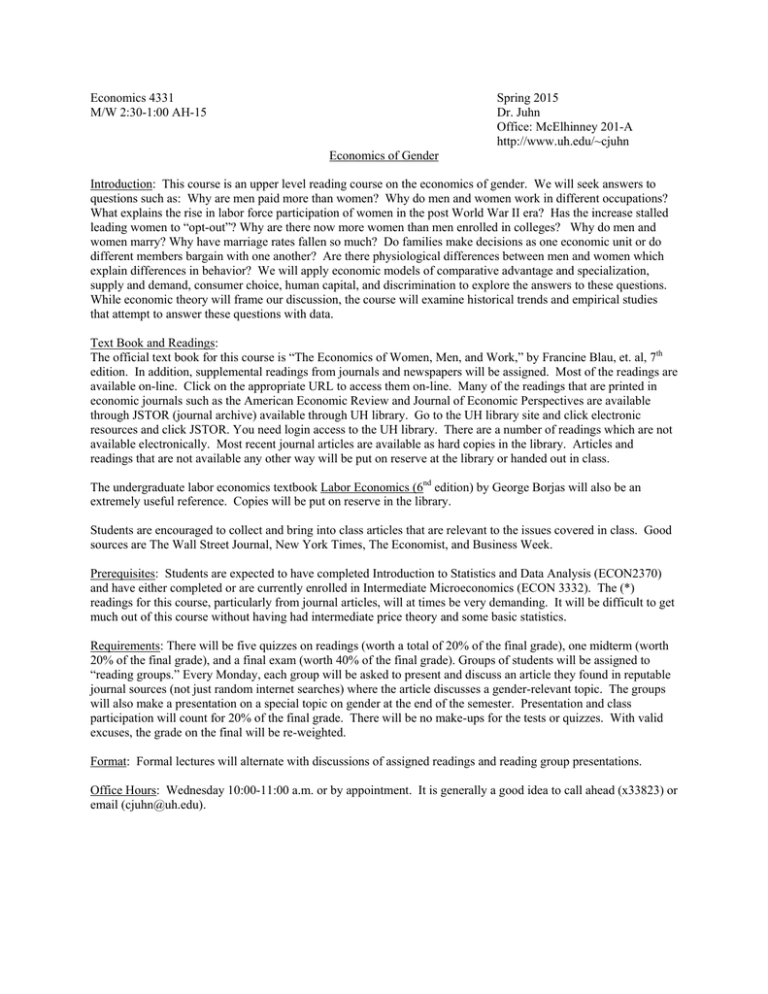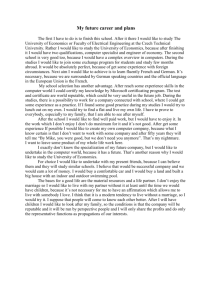Economics 4331 Spring 2015 M/W 2:30-1:00 AH-15
advertisement

Economics 4331 M/W 2:30-1:00 AH-15 Spring 2015 Dr. Juhn Office: McElhinney 201-A http://www.uh.edu/~cjuhn Economics of Gender Introduction: This course is an upper level reading course on the economics of gender. We will seek answers to questions such as: Why are men paid more than women? Why do men and women work in different occupations? What explains the rise in labor force participation of women in the post World War II era? Has the increase stalled leading women to “opt-out”? Why are there now more women than men enrolled in colleges? Why do men and women marry? Why have marriage rates fallen so much? Do families make decisions as one economic unit or do different members bargain with one another? Are there physiological differences between men and women which explain differences in behavior? We will apply economic models of comparative advantage and specialization, supply and demand, consumer choice, human capital, and discrimination to explore the answers to these questions. While economic theory will frame our discussion, the course will examine historical trends and empirical studies that attempt to answer these questions with data. Text Book and Readings: The official text book for this course is “The Economics of Women, Men, and Work,” by Francine Blau, et. al, 7th edition. In addition, supplemental readings from journals and newspapers will be assigned. Most of the readings are available on-line. Click on the appropriate URL to access them on-line. Many of the readings that are printed in economic journals such as the American Economic Review and Journal of Economic Perspectives are available through JSTOR (journal archive) available through UH library. Go to the UH library site and click electronic resources and click JSTOR. You need login access to the UH library. There are a number of readings which are not available electronically. Most recent journal articles are available as hard copies in the library. Articles and readings that are not available any other way will be put on reserve at the library or handed out in class. The undergraduate labor economics textbook Labor Economics (6nd edition) by George Borjas will also be an extremely useful reference. Copies will be put on reserve in the library. Students are encouraged to collect and bring into class articles that are relevant to the issues covered in class. Good sources are The Wall Street Journal, New York Times, The Economist, and Business Week. Prerequisites: Students are expected to have completed Introduction to Statistics and Data Analysis (ECON2370) and have either completed or are currently enrolled in Intermediate Microeconomics (ECON 3332). The (*) readings for this course, particularly from journal articles, will at times be very demanding. It will be difficult to get much out of this course without having had intermediate price theory and some basic statistics. Requirements: There will be five quizzes on readings (worth a total of 20% of the final grade), one midterm (worth 20% of the final grade), and a final exam (worth 40% of the final grade). Groups of students will be assigned to “reading groups.” Every Monday, each group will be asked to present and discuss an article they found in reputable journal sources (not just random internet searches) where the article discusses a gender-relevant topic. The groups will also make a presentation on a special topic on gender at the end of the semester. Presentation and class participation will count for 20% of the final grade. There will be no make-ups for the tests or quizzes. With valid excuses, the grade on the final will be re-weighted. Format: Formal lectures will alternate with discussions of assigned readings and reading group presentations. Office Hours: Wednesday 10:00-11:00 a.m. or by appointment. It is generally a good idea to call ahead (x33823) or email (cjuhn@uh.edu). Course Outline Dates Topic 1/21, 1/26 Introduction Review economic concepts, supply and demand Averett and Hoffman, Women and the Economy, chapter 3 p. 80-97. Botticini, Maristella. “Marriage Payments,” In Joel Mokyr (ed.), Oxford Encyclopedia of Economic History. New York: Oxford University Press, 2003. (AVAILABLE ONLINE) http://didattica.unibocconi.eu/mypage/index.php?IdUte=107271&idr=11716&lingua=eng Frank, Robert. “Polygamy and the Marriage Market: Who Would Have the Upper Hand?” NYT article, February 5, 2009. http://www.nytimes.com/2006/03/16/business/16scene.html BFW, chap l 1/28 Overview of Women’s Progress BFW, chap 2 Goldin, Claudia “The Quiet Revolution That Transformed Women’s Employment, Education, and Family,”American Economic Review, May 2006. (AVAILABLE ONLINE) http://www.economics.harvard.edu/faculty/goldin/files/GoldinEly.pdf 2/2, 2/4 2/9, 2/11 Economics of Marriage and the Family Specialization and exchange: comparative advantage Benefits of marriage Evolution of American family Household bargaining models BFW, chap 3, 4, and chap 9 2/4 Quiz 1 Isen, Adam, and Betsy Stevenson, “Women’s Education and Family Behavior: Trends in Marriage, Divorce and Fertility.” In John Shoven, ed. Demography and the Economy, University of Chicago Press, 2010. http://bpp.wharton.upenn.edu/betseys/papers/Marriage_divorce_education.pdf Stevenson, Betsey “The Evolution of the American Family: An Economic Interpretation,” mimeo, Fall 2008. http://bpp.wharton.upenn.edu/betseys/papers/Evolution_Family.pdf Lundberg, Shelly, and Robert A. Pollack, “The American Family and Family Economics,” Journal of Economic Perspectives 21, no.2 (Spring 2007) (JSTOR) Lillard, Lee, and Constantijn Panis , “Marital Status and Mortality: The Role of Health,” Demography, Vol. 33, No. 3 (Aug., 1996). (JSTOR) Waite, Linda “Does Marriage Matter?” Demography, Vol. 32, No. 4 (November, 1995). (JSTOR) (*) Grover, Shawn, and John Helliwell, “How’s Life at Home: New Evidence on Marriage and the Set Point for Happiness.” NBER working paper 20794. December 2014. http://www.nber.org/papers/w20794.pdf “Study Finds More Reason to Get and Stay Married” NYT article published Jan 2015. http://www.nytimes.com/2015/01/08/upshot/study-finds-more-reasons-to-get-and-staymarried.html?abt=0002&abg=1 “Is Marriage Good for Your Health” NYT article published April 2010. http://www.nytimes.com/2010/04/18/magazine/18marriaget.html?scp=1&sq=is%20marriage%20good%20for%20you&st=cse “51% of Women Live Without a Spouse” NYT article published Jan 2007. http://sfgate.com/cgi-bin/article.cgi?file=/c/a/2007/01/16/MNG5BNJ69L1.DTL&type=printable (*) Charles, Kerwin, and Ming Chung Luoh, “Male Incarceration, the Marriage Market, and Female Outcomes.” The Review of Economics and Statistics, August 2010 (JSTOR). http://www.slate.com/articles/arts/the_undercover_economist/features/2008/the_logic_of_life/the_ economics_of_marriage.html Lundberg, Shelly, and Robert A. Pollack, “Bargaining and Distribution in Marriage,” Journal of Economic Perspectives 10, no.4 (Fall 1996) (JSTOR) 2/16, 2/18, 2/23 Rise in Married Women’s Labor Force Participation 2/25, 3/2, 3/4 3/9 Trends in female and male labor supply Basic theory: consumption-leisure model Factors that led to rise in labor market participation - Demand-side: industrial change and demand for female labor - Supply-side: husband’s income, the “Pill,” divorce Is the “Opt-out revolution” real? Maternity benefits and child-care subsidies BFW, chap5, 6 2/18 Quiz 2 3/4 Quiz 3 Costa, Dora. “From Mill Town to Board Room: The Rise of Women’s Paid Labor,” Journal of Economic Perspectives, Vol. 14, No. 4, Autumn 2000. (JSTOR) Goldin, Claudia and Lawrence Katz. “Career and Marriage in the Age of the Pill,” American Economic Review Papers and Proceedings 90 (May 2000). (JSTOR) Bertrand, Marianne, Goldin, Claudia and Lawrence Katz. “Dynamics of Stevenson, Betsy and Justin Wolfers,” Marriage and Divorce: Changes and their Driving Forces,” Journal of Economic Perspectives 21 (Winter 2007). (AVAILABLE ONLINE) http://bpp.wharton.upenn.edu/jwolfers/Papers/MarriageandDivorce(JEP).pdf (*) Bertrand, M., Goldin, C. and L. Katz, “Dynamics of the Gender Gap for Young Professionals in the Financial and Corporate Sectors,” forthcoming, American Economic Journal: Applied Economics. Bertrand, Marianne, “Career, Family, and the Well-Being of College Educated Women,” American Economic Review, 2013, 103(3): 244-250. http://faculty.chicagobooth.edu/marianne.bertrand/research/papers/Career%20Family%20and%20t he%20Well-Being%20of%20College%20Educated%20Women.pdf Belkin, Lisa. “The Opt-Out Revolution,” NYT article published Oct 2003. http://www.nytimes.com/2003/10/26/magazine/26WOMEN.html?ei=5007&en=02f8d75eb63908e 0&ex=1382500800&partner=USERLAND&pagewanted=print&position= Add childcare and maternity benefits papers 3/11, 3/23, 3/25 The Gender Gap in Pay 3/30, 4/1 Trends in the Gender Earnings Gap and Occupational Segregation Human Capital Model Regression Analysis (Chapter 7, appendix) Marriage Premium/penalty and family gap Occupational choice and STEM BFW chaps. 7, 8, 9 3/16-3/20 Spring Break 3/25 Midterm Exam Blau, Francine and Lawrence Kahn. “Gender Differences in Pay,” Journal of Economic Perspectives 14 (Autumn 2000) (JSTOR) Waldfogel, Jane. “Understanding the Family Gap in Pay for Women with Children.” Journal of Economic Perspectives 12(1) (JSTOR). Goldin, Claudia, Lawrence Katz, and Ilyana Kuziemko, “The Homecoming of American College Women: The Reversal in the Gender Gap in College,” Journal of Economic Perspectives 20 (Fall 2006). http://kuznets.fas.harvard.edu/~goldin/papers/homecoming.pdf 4/6, 4/8, 4/13 Gender Gap in Pay - Discrimination Theories of discrimination BFW chap 10, 11 4/8 Quiz 4 (*) Goldin, Claudia and Cecilia Rouse. “Orchestrating Impartiality,” American Economic Review 90 (September 2000). (JSTOR) (*) Bertrand, Marianne and Sendhil Mullainathan, “Are Emily and Greg More Employable than Lakisha and Jamal? A Field Experiment on Labor Market Discrimination,” The American Economic Review, 2004, 94(4), 991-1013. http://faculty.chicagobooth.edu/marianne.bertrand/research/emily_lakisha_aer.pdf 4/15, 4/20, 4/22 Nature vs. Nurture: Gender Differences in the Lab Physiological differences, recent experimental evidence BFW chap 9 4/22 Quiz 5 Summers, Lawrence. “Remarks at NBER Conference on Diversifying the Science & Engineering Workforce”, January 2005 (AVAILABLE ONLINE) http://www.president.harvard.edu/speeches/2005/nber.html (*) Niederle, Muriel and Lise Vesterlund. “Do Women Shy Away from Competition? Do Men Compete Too Much? NBER Working Paper No. 11474, June 2005. http://www.nber.org/papers/w11474 Non-technical summary of the paper http://www.nber.org/digest/feb06/w11474.html (*) Bertrand, Marianne, “New Perspectives on Gender”, forthcoming in Orley Ashenfelter and David Card eds, Handbook of Labor Ecomics, December 2010, volume 4B, pp. 1545-1592. 4/27, 4/29 Group Presentations 5/4 Review Final Exam – Friday, May 8, 2-5 p.m.
